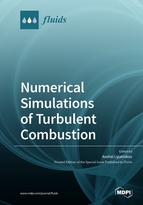Numerical Simulations of Turbulent Combustion
A special issue of Fluids (ISSN 2311-5521).
Deadline for manuscript submissions: closed (15 June 2019) | Viewed by 27626
Special Issue Editor
Interests: premixed turbulent flames; laminar flames; pollutant formation; gas mixture autoignition
Special Issues, Collections and Topics in MDPI journals
Special Issue Information
Dear Colleagues,
Turbulent burning of gaseous fuels is widely used for energy conversion in stationary power generation, e.g. gas turbines, land transportation, e.g. piston engines, and aviation, e.g. aero-engine afterburners. Nevertheless, fundamental understanding of turbulent combustion is still limited, because it is a highly non-linear and multiscale process that involves various local phenomena and thousands (e.g. for gasoline-air mixtures) of chemical reactions between hundreds of species, including a number of reactions that control emissions from flames. Therefore, there is a strong need for elaborating high fidelity, advanced numerical models and methods that will catch the governing physical mechanisms of flame-turbulence interaction and, consequently, will make turbulent combustion computations an efficient predictive tool for applied research and, in particular, for development of a new generation of ultra clean and highly efficient internal combustion engines that will allow the society to properly respond to current environmental and efficiency challenges. Accordingly, this Special Issue seeks papers aimed at (i) contributing to fundamental understanding of flame-turbulence interaction by analyzing results of unsteady multi-dimensional numerical simulations and (ii) developing and validating high fidelity models and efficient numerical methods for Computational Fluid Dynamics research into turbulent combustion in laboratory burners and in engines.
Prof. Andrei Lipatnikov
Guest Editor
Manuscript Submission Information
Manuscripts should be submitted online at www.mdpi.com by registering and logging in to this website. Once you are registered, click here to go to the submission form. Manuscripts can be submitted until the deadline. All submissions that pass pre-check are peer-reviewed. Accepted papers will be published continuously in the journal (as soon as accepted) and will be listed together on the special issue website. Research articles, review articles as well as short communications are invited. For planned papers, a title and short abstract (about 100 words) can be sent to the Editorial Office for announcement on this website.
Submitted manuscripts should not have been published previously, nor be under consideration for publication elsewhere (except conference proceedings papers). All manuscripts are thoroughly refereed through a single-blind peer-review process. A guide for authors and other relevant information for submission of manuscripts is available on the Instructions for Authors page. Fluids is an international peer-reviewed open access monthly journal published by MDPI.
Please visit the Instructions for Authors page before submitting a manuscript. The Article Processing Charge (APC) for publication in this open access journal is 1800 CHF (Swiss Francs). Submitted papers should be well formatted and use good English. Authors may use MDPI's English editing service prior to publication or during author revisions.
Keywords
- turbulence
- combustion
- flame
- reacting flow
- numerical modeling
- direct numerical simulation
- large eddy simulation
- computational fluid dynamics






